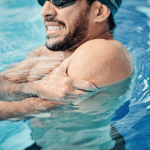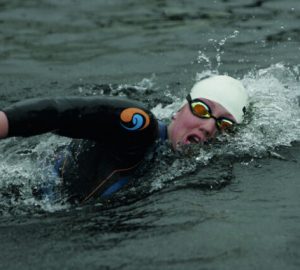Theodore Yach and the great wetsuit debate
Last week we learned about the sudden and untimely death of Theodore Yach, one of South Africa’s most accomplished and best-known swimmers. He was just 60 years old. I met him only once, a few years ago at a dinner in London, and we had a lively and interesting discussion about swimming. He told me how, on one of his Robben Island attempts, his crew spotted a shark and wanted to get him out of the water as quickly as possible. The only things they could get hold of to haul him into the boat were his ears, so that’s what they did. I would have liked to have known him better. By all accounts he was popular and hugely supportive of other swimmers. He also swam an incredible 108 times from Robben Island to Cape Town and completed an English Channel crossing.
Theodore was a committed non-wetsuit swimmer and entered into a fierce debate, conducted through the letters’ page of Outdoor Swimmer, with swimmers who had different views about neoprene. His opinion was forthright and non-compromising:
He wrote: “On many of the world’s iconic swims beating the cold is 90% of the challenge. Time in the water is not the issue. Getting to point B is the only objective. My mantra is Suffer to succeed and I warrant that an investigation into the attitude of my peers across the globe will yield a similar answer. Wetsuits remove much of the suffering so I repeat my assertion that to attempt an English Channel, Robben Island or similar crossing is cheating by weaklings. Is this an elitist view? Absolutely! No apology offered.”
While I dislike Theodore’s “cheating by weaklings” comment, I do understand his point. What is particularly irksome for traditional swimmers are people claiming to have completed certain swims but neglecting to mention that they used a wetsuit and implying that their achievements are equivalent.
A few years ago, I swam a length of Windermere without a wetsuit. I finished, but I ended up in hospital with hypothermia. My memory of the swim is hazy, but I do remember feeling cold, sick and miserable. I definitely suffered. Earlier this year, I did the same swim again but with a wetsuit. I thoroughly enjoyed the swim. I wasn’t cold. I paid attention to my surroundings and noted the landmarks as we progressed up the lake. Swimming felt comfortable and easy right to the end and, most importantly, I didn’t need medical assistance and I have great memories! There was no suffering required.
Without any doubt, the second swim was considerably easier than the first. It wasn’t just the warmth of the wetsuit that helped but also the buoyancy, which supports an efficient swimming position and allowed me to simply float at feed stops rather than energetically tread water.
But was this cheating? Surely, it’s only cheating if you claim something that you haven’t done or imply your achievement in a wetsuit is similar to doing the same swim without, when it clearly isn’t. Like many people, I swim for my own pleasure, not to set records. Wearing a wetsuit makes it possible for me to do long swims in relatively cool water, and enjoy them while I’m doing them.
I also like swimming in open water without a wetsuit. I love how the water changes from feeling cold to delightfully electrifying as your skin cools down during those first few moments and I relish the freedom of movement you have. I frequently encourage other people to try swimming without the neoprene for these reasons. But you need to know your limits. Some people used words such as “courageous” or “tough” to describe how I pushed through the cold and discomfort on my first Windermere swim. Others said it was just stupid. I’ll leave it to you to decide which you think it was.
Theodore’s debate aside, since we launched Outdoor Swimmer (previously H2Open) in 2011, we’ve noticed a gradual softening in the tone in the debate between wetsuit and non-wetsuit swimmers – which is a good thing. There are also, it seems, increasing numbers of swimmers who will sometimes wear a wetsuit, and sometimes not, depending on circumstances, mood and conditions.
At Outdoor Swimmer we celebrate all types of outdoor swimming: wetsuit or non-wetsuit; fast and furious or serene and social; ice dipping in winter or leisurely river meanderings in summer. The key is to do the swims you want to do, as you want to do them, enjoy the water and stay safe.
That said, we have huge respect for traditional non-wetsuit marathon swimming and the people who continue to do it and promote it. Theodore, you’ll be missed. We hope that part of your legacy will be the continued celebration of traditional swimming, especially for iconic swims such as the English Channel and Robben Island.
#SwimWildandFree








